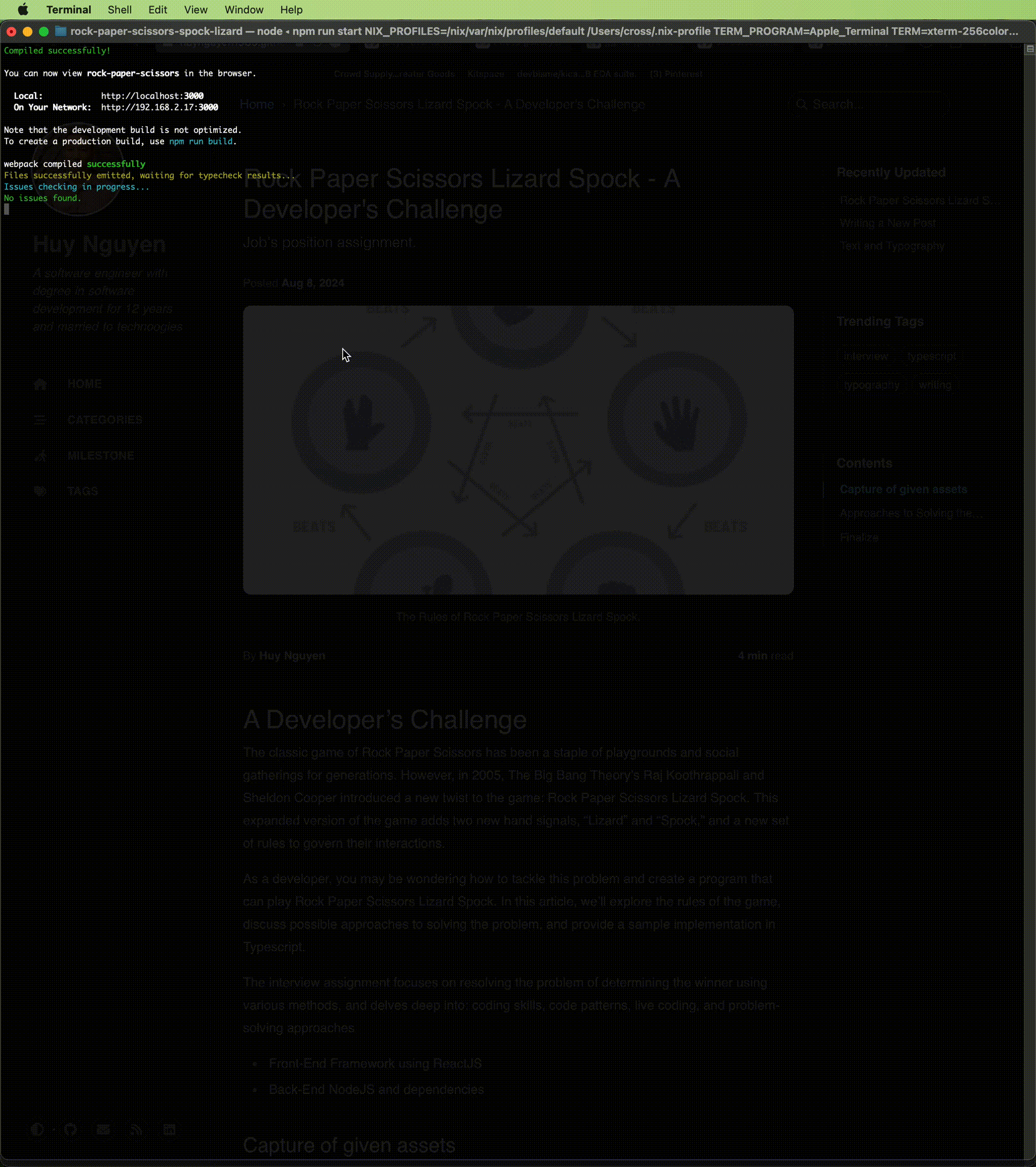Rock Paper Scissors Lizard Spock - A Developer's Challenge
Job's position assignment.
A Developer’s Challenge
The classic game of Rock Paper Scissors has been a staple of playgrounds and social gatherings for generations. However, in 2005, The Big Bang Theory’s Raj Koothrappali and Sheldon Cooper introduced a new twist to the game: Rock Paper Scissors Lizard Spock. This expanded version of the game adds two new hand signals, “Lizard” and “Spock,” and a new set of rules to govern their interactions.
As a developer, you may be wondering how to tackle this problem and create a program that can play Rock Paper Scissors Lizard Spock. In this article, we’ll explore the rules of the game, discuss possible approaches to solving the problem, and provide a sample implementation in Typescript.
The interview assignment focuses on resolving the problem of determining the winner using various methods, and delves deep into: coding skills, code patterns, live coding, and problem-solving approaches
- Front-End Framework using ReactJS
- Back-End NodeJS and dependencies
- Javascript transpiler: Typescript
Steps to resolve
flowchart TD
A[Assignment Assets] --> B(Read and Analyze)
B --> C{Approaches following given pattern}
C -->|1st| D[If-Else Force]
C -->|2nd| E[Modular Approach]
C -->|3rd| F[Polar Coordinate System]
D & E & F --> | Decision | Result
Capture of given assets
Of couse every assignment would not be in happy path :cry:  Built and run
Built and run
 After hours of reading and fixed everything now in place
After hours of reading and fixed everything now in place
Approaches to Solving the Problem
1. If-Else Force
1
2
3
4
5
6
7
8
9
10
11
12
13
14
15
16
17
18
19
20
21
22
23
24
25
26
27
export const winner = (player1: string, player2: string): string | undefined => {
let winner: string = '';
if (player1 === 'scissors') {
if (player2 === 'scissors') winner = 'draw';
else if (player2 === 'paper' || player2 === 'lizard') winner = player1;
else winner = player2;
} else if (player1 === 'paper') {
if (player2 === 'paper') winner = 'draw';
else if (player2 === 'rock' || player2 === 'spock') winner = player1;
else winner = player2;
} else if (player1 === 'rock') {
if (player2 === 'rock') winner = 'draw';
else if (player2 === 'lizard' || player2 === 'scissors') winner = player1;
else winner = player2;
} else if (player1 === 'lizard') {
if (player2 === 'lizard') winner = 'draw';
else if (player2 === 'spock' || player2 === 'paper') winner = player1;
else winner = player2;
} else if (player1 === 'spock') {
if (player2 === 'spock') winner = 'draw';
else if (player2 === 'scissors' || player2 === 'rock') winner = player1;
else winner = player2;
} else winner = 'draw';
return winner;
};
2. Modular Approach
import { SIGN } from 'types'
export const rules = {
[SIGN.PAPER]: new Set([SIGN.ROCK, SIGN.SPOCK]),
[SIGN.ROCK]: new Set([SIGN.SCISSORS, SIGN.LIZARD]),
[SIGN.SCISSORS]: new Set([SIGN.PAPER, SIGN.LIZARD]),
[SIGN.LIZARD]: new Set([SIGN.SPOCK, SIGN.PAPER]),
[SIGN.SPOCK]: new Set([SIGN.ROCK, SIGN.SCISSORS]),
}
1
2
3
4
5
6
7
8
9
10
11
12
export const findOutResult = (playerPick: SIGN, computerPick: SIGN): RESULT => {
if (!playerPick) return RESULT.PLAYER_HAS_NOT_CHOSEN_YET
if (playerPick === computerPick) return RESULT.DRAW
else if (rules[playerPick].has(computerPick)) {
return RESULT.PLAYER_WIN
} else {
return RESULT.COMPUTER_WIN
}
}
3. Polar Coordinate System - My approaching for more than 5 choices
1
2
3
4
5
6
7
8
9
10
11
12
13
14
15
16
17
18
19
20
21
22
23
24
25
26
27
28
29
Number of possible cases, we can multiply the number of choices for each player
- 5 choices = 5*5 = 25 total cases
2-D Array from 360/5 = 72 degree for each choice
1 Radian = 180/π = 57.296 Deg
2π * rad = 360
2π/3 * rad = 120 deg
π/3 * rad = 60 deg
1 Degree = degree * π/180 = 0.0174 Radial
- List of choices would be [2π/5, 4π/5, 6π/5, 8π/5, 2π]
- Following game's rules checking the angle of 2 choices
If Choice-1 === choice-2 => Draw
(If both choices from same position)
--- Circular rule ---
If |choice-1 - choice-2| == 2π/5 => choice-1 win
(check user's choice at X-position - 72 degree => Y-position of computer's choice => that's mean user's winning)
If |choice-2 - choice-1| == 2π/5 => choice-2 win
(check computer's choice at X-position - 72 degree => Y-position of computer's choice => that's mean computer's winning)
--- Hexagon rule ---
If choice-1 - 2π/3*rad = choice-2 => chocie-1 win
(Check angles of both choices in between 144 Degree)
1
2
3
4
5
6
7
8
9
10
11
12
13
14
15
16
17
18
19
20
21
22
23
24
25
26
27
28
29
30
31
32
33
/* Items in circular position within position-error correction */
.select-container, .items-circular--position {
padding: 7rem;
transform: rotate(-18deg)
}
/* Angles - The use of some css preprocessor would be nice for iteration*/
.deg72 {
position: absolute;
transform: rotate(72deg) translate(145px) rotate(-95deg);
}
.deg144 {
position: absolute;
transform: rotate(144deg) translate(145px) rotate(-144deg);
}
.deg216 {
position: absolute;
transform: rotate(216deg) translate(145px) rotate(-216deg);
}
.deg288 {
position: absolute;
transform: rotate(288deg) translate(145px) rotate(-288deg);
}
.deg360 {
position: absolute;
transform: rotate(360deg) translate(145px) rotate(-360deg);
}
Finalize
So, the easiest way to implement the function to detect a winner would be the 1st and 2nd options, as they offer the best clarity and simplicity
The advantage of the 3rd solution is that it allows to extend to many many choices and for a more consistent implementation of the UI and solution and of course it’s take time and it's out of scope.
Code Reposistory
https://github.com/huynguyen1989/rock-paper-scissor-lizard-spock

